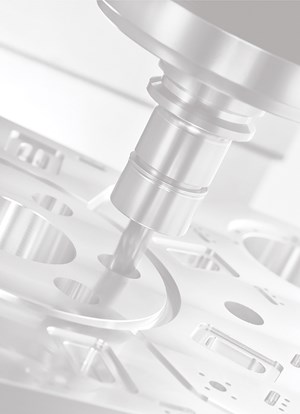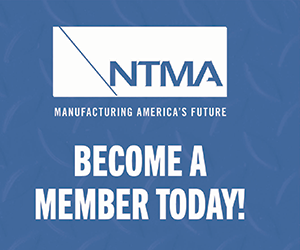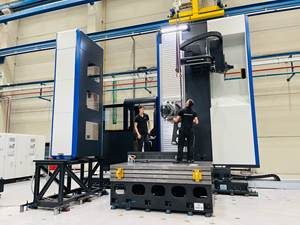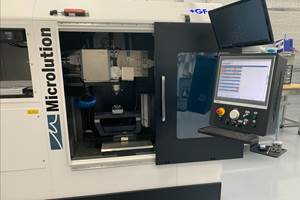The Human Impact of Machining Technology
SSP’s commitment to adopting the latest machining technology benefits not only the business, but its employees as well.
Share



SSP reinvests its profits into the company, enabling it to implement the latest machining technology. Not only does this improve its machining operations, it serves as an employee retention strategy as well. Photos provided by SSP.
Machining technology affects many aspects of a manufacturing business — the type of work it does, its throughput, the quality of its work and more. But one underappreciated impact of machining technology is its influence on a manufacturer’s workforce. “One of the things we figured out when moving to the latest, greatest, best manufacturing technology is that people like it,” says David King, owner, president and CEO of SSP. “It’s more fun to work with new equipment as opposed to old equipment. It engages the workforce more.”
By reinvesting profits back into the company into the company, SSP has been able to stay on top of machining technology. It has 50 machine tools in its Twinsburg, Ohio facility, including rotary transfer machines and multi-spindle, twin-spindle and single-spindle lathes. This lineup of complex machine tools made SSP stand out in the 2024 Top Shops data, securing its spot as the Machining Technology honoree.
SSP was founded in 1926 as a job shop. King’s grandfather purchased it in the 1950s, and it has remained in the family for the last three generations. “My grandfather, my father, my brother and I have all run the business,” he notes. In the 1970s, his father transformed the company from a job shop to one that produces and sells a catalog of products, primarily valves and fittings for instrumentation and industrial applications. “We go across pretty much every vertical that needs to be able to move or measure media in a gas or liquid application,” says Vice President of Marketing Kristin Evans.

SSP’s shop floor is divided into high-, medium- and low-volume production. The high-volume production area, which used to consist of chucker lathes, is now populated with multi-spindle lathes such as these, and rotary transfer machines, all with Siemens-based controls.
Safety
Within the shop, the machines are organized by the part volumes they’re used to produce. High-volume production (1,000 pieces or more) equipment includes multi-spindle lathes and rotary transfer machines. According to Paul Omilion, vice president of manufacturing, just two of its five rotary transfer machines are doing the same work that once required 28 chucker lathes.
King notes that not only are the rotary transfer machines more efficient than chucker lathes, they’re also safer. The old, chucker-style lathes required operators to change out parts manually by reaching into the machine and closing the chuck around the part using a foot pedal. “There was a lot of potential for hand injuries,” Omilion acknowledges. Safer machines benefit both the employer and its employees. “We're just under 10 years without a lost time accident in our facility, which is a fantastic record, and the technology helps with that,” King adds.

Muratec lathes with FANUC controls populate the medium- and low-volume production areas. Standardizing the machines and controls enables operators to move around within the medium- and low-volume areas as needed.
Standardization
For medium-volume (100 to 1,000 pieces) production, SSP uses twin-spindle, twin-turret lathes, while single-spindle, single-turret lathes handle low-volume parts (under 100 pieces). SSP makes a conscious effort to standardize the machine tools and controls in each area of the business, using Muratec lathes from Murata, multi-spindle machines from Schütte and rotary transfer machines from Hydromat, all equipped with controls from FANUC in the low- and medium-volume areas and Siemens in the high-volume area. The controls might be slightly different depending on the machine tool, but because they’re based on the same platform, they operate in a similar way. “It all looks the same to the operators,” Omilion explains. This enables operators to move within the low- and medium-volume areas with relative ease because the technologies cross over. However, the high-volume area’s technology is so different that it has its own operators.
Omilion also points out that standardizing machine platforms benefits more than the machine operators. “It’s the same thing with repair for our maintenance team,” he says. “The components are very similar.” Overall, King says this strategy maximizes the company’s flexibility.

More advanced machine tools such as this rotary transfer machine have enabled SSP to eliminate secondary operations such as deburring, drilling, buffing and thread rolling.
One and Done
King says that many of SSP’s machining technology decisions are driven by its goal of eliminating secondary processes. “The overarching strategy is to take work in process out of the business,” King explains. “Chuck it once and be done with it.”
Replacing old, cam-driven turning machines with CNC multi-spindle and rotary transfer machines with more machining capabilities has all but eliminated secondary operations at SSP. “I started here as a manufacturing engineer back in the early ‘90s and we had at least two dozen people working in what we used to call secondary operations or auxiliary operations, basically handling parts, doing deburring, drilling, buffing, thread rolling and so on and so forth,” says Omilion. “Nowadays, that department doesn't exist.”
The only post-machining operations the shop does now are cleaning parts and putting protective caps on threaded parts. Again, not only is this more efficient for the business, but it eliminates tedious and often physically strenuous manual labor while freeing up employees for higher-value, more interesting work.
Automation
SSP has also increasingly adopted automation as a response to difficulties in finding new employees. “The labor shortage is here to stay, so the more we can automate the better,” King says. While the company has multiple automation systems and experience working with both outside and in-house integrators (the success of which King attributes to SSP’s “extremely talented maintenance people”), he notes that some of its most effective automation systems have come from its machine tool suppliers. In fact, the shop’s first automation experience came when it worked with Hydromat to automate tending of its rotary transfer machines. All of its twin-spindle, twin-turret Muratec lathes also have built-in gantry loaders that pick up a precut slug or forging from an infeed conveyor and loads it into the chuck for op. 1. When that’s done, it grabs the part, repositions it and loads it into the second chuck for op. 2. Then it grabs the finished part and puts it on an outfeed conveyor.
The company is also automating its assembly area. Many of SSP’s parts require fittings, ferrules and nuts, which used to be assembled by hand. Now the shop has two automated assembly cells with a bowl feeder, robots and inspection capabilities, as well as a robotic cell to put protective caps on threaded parts. This cell has a vision system with two cameras — one to ensure the parts are oriented correctly, and another to ensure the caps are oriented correctly. King says that, thanks to these systems, the assembly department, which used to employ approximately a dozen people, now only requires a few.
The warehouse is another area of automation, where SSP has implemented a carousel-based system. “We’re able to pick and pack orders with great efficiency,” King notes.
With all of this automation, one might assume that the shop runs lights out. But this isn’t the case, because the shop primarily machines challenging, corrosion-resistant materials such as 316 stainless steel. “Clearing chips out of a machine machining stainless steel is extremely difficult,” Omilion says. “It just creates these big balls of chips that wrap around tools.” The shop can’t leave machines running these materials unattended for long stretches of time. “If I were machining aluminum, carbon steel, brass, it would be no problem,” he continues. “But that's not what we do.” Instead, the shop’s automation is purely a way to respond to the labor shortage, improving employees’ jobs and freeing them for higher-value work. “It takes boring labor out of the process,” King explains.
Machine Monitoring
Likewise, SSP benefits from machine monitoring despite the fact that it doesn’t perform lights-out machining. It uses Techna-Check from Techna-Tool on the Hydromats to monitor the load on all spindles (except the thread rolling spindles). This enables it to predict when tools are wearing out and need to be changed, and stops the machine in the event of a broken tool. “It avoids a lot of crashes and a lot of unnecessary troubleshooting, especially with the less experienced operators,” Omilion says, because newer operators often can’t tell how worn tools are just by looking at them. Manufacturing engineers can also use tool data from Techna-Check to update machine programs with tool changes before they’re needed. “It also gives us data for processing improvements,” Omilion adds.
For more general machine monitoring, the company uses a system integrated into the Hydromats to monitor those machines. This enables the manufacturing engineer in charge of the Hydromats to monitor the machines remotely. He can also troubleshoot machines remotely by adjusting programs or machine settings. Hydromat employees can perform remote diagnostics and sometimes even remote repairs through this system as well.
Investing In Technology
“We're constantly buying and adding,” King notes. The shop has a new parts washing system that’s about to come online, as well as several open purchase orders and plans to add more Schütte multi-spindle machines.
When it comes to new machine purchases, King jokes that these decisions come “with a lot of angst.” He points out that what are typically simple ROI calculations become less clear when considering “soft” factors, such as attracting and retaining employees. But, he adds, “The bottom line is, the new equipment makes better parts faster and more consistently, and therefore it's more profitable.”
Related Content
10 Robotic Solutions You Can Find at IMTS 2026
Discover how today’s robots and cobots are making it easier than ever to automate tasks, free up skilled workers, and run machines unattended – even in small and midsized shops.
Read MoreControlling Extreme Cutting Conditions in Large-Part Machining
Newly patented technologies for controlling chatter and vibration during milling, turning and boring operations promise to drastically reduce production time and increase machining performance.
Read MoreWhere Micro-Laser Machining Is the Focus
A company that was once a consulting firm has become a successful micro-laser machine shop producing complex parts and features that most traditional CNC shops cannot machine.
Read MoreAdditive/Subtractive Hybrid CNC Machine Tools Continue to Make Gains (Includes Video)
The hybrid machine tool is an idea that continues to advance. Two important developments of recent years expand the possibilities for this platform.
Read MoreRead Next
OEM Tour Video: Lean Manufacturing for Measurement and Metrology
How can a facility that requires manual work for some long-standing parts be made more efficient? Join us as we look inside The L. S. Starrett Company’s headquarters in Athol, Massachusetts, and see how this long-established OEM is updating its processes.
Read More




























